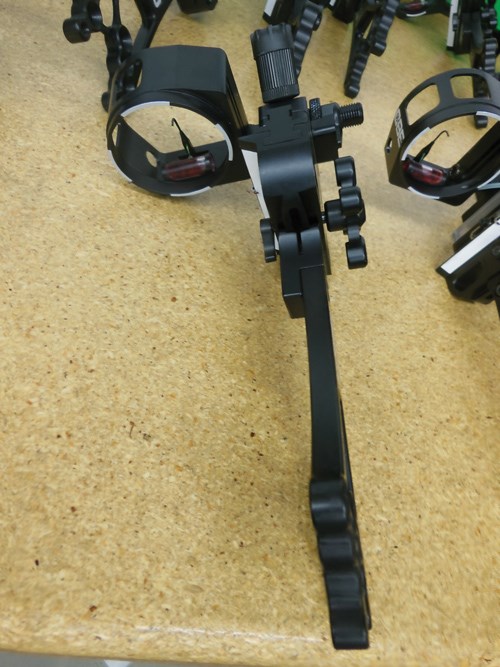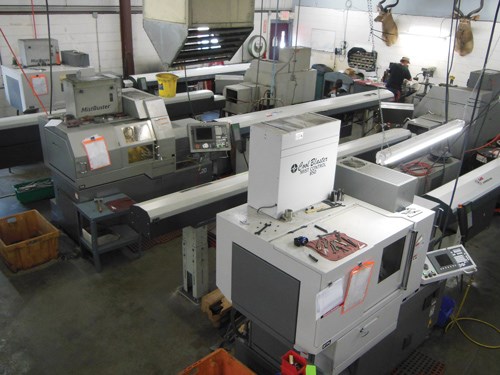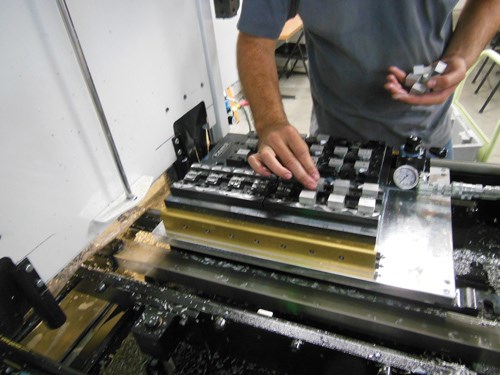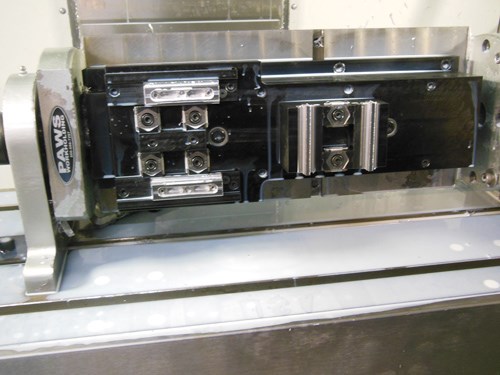Hitting the Target with Creative Workholding
While growth has been steady in its Swiss operations, this archery equipment supplier’s most drastic improvements have come at the hands of the workholding systems on its VMCs.
Sometimes a single significant event can be enough to give a business a new perspective and jumpstart it toward high achievement. Some companies are able to capitalize on such events by following them up with more creative solutions. For 20-plus years, Scott Archery was set on cruise control, content with its slow, steady growth. But when The Outdoor Group, LLC, purchased the company in 2012, higher expectations became the norm. Through some creative work on the shop floor, along with a series of other business acquisitions, the company has been able to briskly expand and shows no signs of slowing.
From the Ground Up
The company was founded more than 25 years ago in the garage of Bill Scott. The company’s core product is a line of releases for use in archery shooting. Working on a manual mill, Mr. Scott was able to produce about 20 parts a day. By 1995, as demand continued to increase, the company had moved into its current facility in Clay City, Kentucky, adding a couple of Fadal mills and a single Citizen Swiss lathe. Production was steadily ramping up, and within a few more years, the company was producing about 35,000 parts per year. But things were only starting to get interesting.
The company was experiencing steady growth, so it was easy to accept the status quo and continue with little change. But much potential was going untapped. Finally in 2008, company management became more aggressive and purchased Custom Bow Equipment (CBE), a manufacturer of high quality target sights. To support this move, the company also expanded its CNC machining equipment and staff to broaden the CBE brand name and designs and to strengthen its overall position in the market.
Early in 2012, seeing the success of the companies and growing demand for Scott Archery’s products, The Outdoor Group, owner of bow manufacturer Elite Archery, completed its acquisition of Scott. A year later, Winner’s Choice Custom Bowstrings was added to the fold to bring together a conglomerate that reaches a range of archery shooting needs.
Making the Most
Although the original brands remain after the mergers and acquisitions, and some of the existing manufacturing facilities continue production, the potential of the Scott facility would not be overlooked this time. While it continues to make parts for its releases, it has also been heavily involved in production of parts for both CBE and Winner’s Choice. And production and sales goals continue to shoot up at an extraordinary pace.
Only a few years ago, along with some vertical milling centers, the company had one underutilized Citizen Swiss machine. Wayne Collins, director of machine operations, admits that the company was even trying to sell it. “The Swiss machine didn’t seem like something we needed,” he says. “The operator at the time hadn’t found a way to make good use of it, but the personnel we now have on the floor see things in a different way.”
Mr. Collins speaks highly of his current shopfloor crew, but in the case of the Swiss department, he specifically commends Lance Horn, the lead machinist on the Citizens. Yes, not only does the company now have more than one; it recently installed its eleventh, with a twelfth currently on order.
So why the change of heart regarding the approach to Swiss? Mr. Collins has unleashed the machines’ milling capabilities and applied them to the extensive line of prismatic parts that the company produces. “In the past, we would blank parts off on the lathe, and then move them to the vertical,” he says. With a lot more setups and part handling than they wanted, the Swiss machining seemed to be slowing them down. But he has shown Lance Horn that there is a better way. “With Lance’s knowledge and, frankly, his willingness to try new things, we’re now able to do all of our jaws and heads complete on the Citizens.” And with a 12-foot bar loader on each machine, they run lights out, 24/7, providing parts 10 times faster than before.
“When these parts were being produced on the mills, we had to pay a person to stand there while the parts went through three different operations with multiple setups and handlings,” Mr. Collins says. “When the jaws would come back from anodizing, we had another person who would have to ‘mic’ them and match them up for assembly. It was a massive job. On the Citizens, we run a short jaw and a long jaw, it drops them off and counts it as a single cycle. We run batches of 1,000, and send them out for anodizing. When they come back, assembly is simple.”
Scott Archery clearly has found ways to step up its game through improved Swiss machining operations. But surprisingly, better production advances are taking place elsewhere on the shop floor.
Increasing VMC Production
In the milling department, along with its two older model Fadal machines, Scott Archery is now running four Haas VF-2SS VMCs, a VF-3SS VMC, and a Haas DT-1 vertical drill and tap center. While these machines make a few parts for Scott releases, most of their machining time is devoted to requirements of the other divisions of the company (such as a micro windage unit—a precision piece used for slight aiming adjustments on a CBE sight).
According to Mr. Collins, this department has no shortage of star employees either. “We make quality products,” he says. “But what makes our quality? It’s the people. We have great machines and great equipment, but if the people running it don’t care, nothing will improve around you. These guys are always looking for better ways.”
Leading the way in the milling department is Robbie Walters. Like Mr. Horn, he’s young and open to new ideas. This approach has served him well as the department has incorporated automated clamping systems from PAWS Workholding (PAWS stands for pressure actuated workholding systems) as a method of increasing production to keep up with the growing demand.
So far, this move has proven to be a wise choice. According to Vice President Eric Griggs, the systems have helped to decrease costs by at least 35 percent. “The fastest growing part of our business is the CBE target sights,” says Mr. Griggs, who is also a professional shooter. “All that equipment runs on the verticals, where the PAWS Workholding systems come into play. It has increased production and efficiency tremendously.” Mr. Collins adds that some parts are being produced 75 percent faster.
Workholding Creativity
The PAWS system is intended primarily to hold a series of small, round or multi-sided parts for secondary operations such as milling, drilling, tapping and slotting. Depending on the system selected, parts are held on their ID or OD or are clamped in vises with soft jaws.
The workholding system consists of a hydraulic base plate, a fixture plate, a hydraulic pump and a control valve. The fixture plate bolts to the hydraulic base plate and is interchangeable with other fixture plates set up for different parts, making for fast change-overs. As many as 80 points of clamping are available, every 2 inches on center, and the operator selects the points of clamping best suited to his or her needs depending on such considerations as part size, configuration and tool clearance. Parts can be hydraulically clamped by the inside or outside dimension and in a vertical or horizontal orientation.
The electric-hydraulic pump is the power supply to the system. It provides as much as 3,000 psi and is powered with standard shop air. With the standard package, multiple parts are loaded in and removed from the fixture mounted in the machine, which is a big improvement over loading/unloading one, two or several parts at a time. However, the system is also available with an optional accumulator, which enables it to remain hydraulically charged with the hoses disconnected. With the accumulator, the system can be loaded with parts to be machined and pressurized away from the machine, permitting a pallet-switching arrangement for more machine uptime.
This pallet-changing method is bringing the most dramatic results for Scott Archery. One particular part was taking about 3 minutes and 15 seconds to run on the VF-2SS with standard vises. When Mr. Walters moved it to the DT-1 and the PAWS pallet changer, he was able to cut the time to 52 seconds by running 32 parts per pallet. “Previously we were losing load time, but now we load one pallet while the other is making parts,” he says. “Now it’s only 35 seconds to change pallets, and it doesn’t take long to set up the pallet when it’s going on the same machine. We plug the same offset numbers back in, load the plates back on, retouch the tools, and we’re good to go.”
Working with the engineers at PAWS, Scott Archery has developed some other approaches to get more out of the workholding systems. When they first implemented the PAWS system on a VF-2SS, they discovered that by turning the pallets 90 degrees they could fit two on the machine and add to the advantage. Now Scott Archery is running three pallets at a time on the VF-3SS. A part that originally ran at 13 minutes is now down to 2.5 minutes. Mr. Collins says, “We’ll make 10 or 12 thousand of these, saving 10.5 minutes per part. At that rate it doesn’t take long to justify the cost of the system.”
Keys to Success
While Scott Archery has been moving in a positive direction for many years, Mr. Collins sees a number of factors playing a role in the company’s recent unprecedented growth. The personnel are a big part of it. “These guys care,” he says. “We don’t own the business, but the work is ours, and we’re responsible for anything that goes out that door. If it comes out of our department, we made it, and it has our name on it.”
On the business side, bringing together a series of related products through acquisitions has allowed the company to broaden its reach to the market, but has also stepped up the demand for product. On the production side, the PAWS systems have played a major role in helping the company deliver on those demands that increased business has brought.
“The PAWS Workholding system has really taken us to a new level,” Mr. Collins says. “It provides so many options for workholding. If you can run it on a vise and you have an imagination, you can use PAWS. Consult with the company, and they’ll show you how to increase output with better ways to hold your parts.”
— Marubeni Citizen-Cincom Inc.
Related Content
Parting Off: The Case for Standardizing on Sawing
The value of rotary saw cutting for parting off operations could boil down to simple economics paired with process efficiency gains.
Read MoreAutomation Breakthroughs Revolutionize Precision Machining for Complex Parts
Marubeni Citizen-Cincom delivers custom solutions to address some of the biggest challenges in precision machining from handling small parts, to robot integration and unique tooling needs.
Read MoreThe Value of Swiss-Types Milling Rectangular Medical Parts
High-speed spindle technology was key to effective milling of small cardiac monitoring components complete on a CNC sliding-headstock machine platform instead of running them across two mills.
Read MoreShop Sets its Sights on Precise Tool Alignment
A Wisconsin shop has found that visual tool alignment technology has improved tool life and surface finishes for its Swiss-type lathes while increasing throughput as well.
Read MoreRead Next
The Many Sides of Workholding
Here's a broad look at different ways to approach workholding, from bar feeders to collet chucks to robotics.
Read More5 Aspects of PMTS I Appreciate
The three-day edition of the 2025 Precision Machining Technology Show kicks off at the start of April. I’ll be there, and here are some reasons why.
Read MoreA Tooling Workshop Worth a Visit
Marubeni Citizen-Cincom’s tooling and accessory workshop offers a chance to learn more about ancillary devices that can boost machining efficiency and capability.
Read More















.png;maxWidth=300;quality=90)











